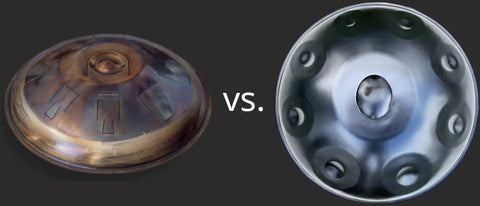In this article, we explore the subtle distinctions between two modern instruments that enrich the world of percussion and musical well-being: the Handpan and the Tongue Drum.
Born in the 21st century, these percussion instruments share many characteristics, but reveal their own identities, far from the image of "twin brothers" that might be attributed to them.
Through an in-depth analysis, we'll guide you in choosing between these two musical gems, whether you're looking for a hang drum or a tongue drum, used or new, highlighting what makes each instrument unique.

Read: How does a Handpan (or Hang Drum) work?
1. Handpan and Tongue Drum are diatonic instruments
Tongue drums and handpans are diatonic percussion instruments, meaning that they do not include all the notes of the chromatic scale.
The first difference is apparent here. The steel Tongue Drum is a pentatonic or heptatonic instrument, meaning it has five or seven notes per octave.
The Handpan, on the other hand, can also be hexatonic, i.e. with six notes per octave. This is quite rare, but given that it exists, it's worth pointing it out.
a. Scale and tone
Tongue Drums and Handpans are both gems of percussion, offering an immersion in well-being through their haunting sound. However, a fundamental distinction lies in their diatonic musical structure, which clearly sets them apart from chromatic instruments, the latter incorporating all the possible notes of an octave.
The Tongue Drum, generally tuned in pentatonic or heptatonic scales, offers five to seven notes per octave, creating a soft, melodious harmony ideal for relaxation and well-being. This ease of access makes it particularly attractive to musical beginners.
b. Variety and complexity
The Handpan, with its ability to be tuned in hexatonic scales, adds an extra note per octave, offering slightly greater harmonic richness. This hexatonic specificity, although rarer, illustrates the diversity and complexity that the Handpan can achieve, appealing to more experienced musicians or composers looking for new sound textures for their works.
c. Choice according to musical profile
The choice between a Tongue Drum and a Handpan depends on your personal search for sound and your desired musical experience. The Tongue Drum, with its reduced scale, favours a meditative and intuitive approach, perfect for well-being.

In contrast, the Handpan offers a wider palette for musical exploration, suitable for musicians wishing to experiment with more elaborate compositions. These features make the Handpan a popular choice with experts, while the Tongue Drum remains accessible and attractive to beginners or those seeking simplicity.
In short, the choice between these two instruments will depend on the musical experience sought, the scale desired and the intended use, whether for relaxation with a 432 hertz Handpan, composition with a 440 hertz, or simply as an introduction to percussion music.
Ready to explore the spellbinding melodies of the handpan? Discover our collection of diatonic instruments, passionately crafted for a unique musical experience. Explore the enchanting sounds of the hang drum and let yourself be transported by its harmonious vibrations.
Visit our shop today and find the perfect handpan for you!
2. Handpan and Tongue Drum frequencies
Depending on the instrument, the handpan can be played at two frequencies:
- 440Hz,
- 432Hz.
The Tongue Drum can also be played at these two frequencies, although most tank drums are tuned to 440hz.
What consequences does this have? Quite simply, whether or not you can play in an orchestra. In fact, 440Hz is the frequency that the Italian government chose to impose on all orchestras in 1885. Originally, the standard frequency was 435Hz, and the frequency was 432Hz.
In other words, if you want to play in a group like Hang Massive, you'll have to opt for the 440Hz frequency, designed for both instruments.
3. Orchestral compatibility and well-being
The frequency at which an instrument is tuned not only influences its ability to fit into musical ensembles but also affects the listening experience in terms of well-being. Here are the key points to consider:
- Orchestral integration
Opting for the 440Hz frequency ensures compatibility with the majority of modern orchestras and musical ensembles. This is crucial for musicians aspiring to play in groups or to integrate larger compositions.
- Relaxation experience
The 432Hz frequency, often associated with therapeutic and relaxing properties, offers an interesting alternative for those who use their instrument primarily for personal well-being or meditation sessions.
- Personal choice
The decision between 440Hz and 432Hz will depend on your musical aspirations. Whether you're aiming for a group performance or a feel-good experience, the Handpan and Tongue Drum offer flexible options to suit your needs.
This flexibility makes the Hang Drum and Tongue Drum particularly well-suited to a variety of musical contexts, from concerts to meditation circles and individual practices focused on well-being.
Handpan and Tongue Drum: a symphony of well-being. From solo to orchestra, explore the unsuspected harmonies of these magical instruments and let themselves be transported by their relaxing vibrations.
Discover our collection and find the perfect musical partner for your sound journey!
4. Handpan and Tongue Drum play differently
The Tongue Drum has metal tongues numbered from 1 to 7. Each number corresponds to a note, from C to B. Percussion can be done with the hands or with drumsticks.
The Handpan, on the other hand, has no numbering and instead of metal tongues there are dimples. Each dimple allows a note to be played, but is not marked.
The accuracy of the handpan's sound depends largely on the precision with which the instrument maker has hammered the metal structure. The steel hang drum is therefore a more complex instrument to make, but we'll come back to that later.

5. Very different size and weight
Size isn't everything, and that's the reality of the steel Tongue Drum, a small, heavy instrument compared to its big brother the Handpan. The Tongue Drum can weigh up to 8 kilograms, while the Handpan generally weighs only 5 or even 6 kilograms.

The reason lies in the thickness of the metal used to produce the sound of these new instruments. The Tongue Drum requires thicker metal than the Handpan, so it is heavier, but also more resistant.
Dropping a Tongue Drum will not damage the quality of the sound. On the contrary, if you drop your hang drum, there's a good chance that the instrument will be out of tune. Why is this? Because the Handpan's sound is based entirely on the shape of its dome. Any deformation, even when caused by heat, immediately affects the accuracy of its notes.
6. A price difference
Although heavier, the Tongue Drum is approximately less expensive than the Handpan. The reason is that this instrument requires much less technical skill than a handpan.
Handpans cannot be machined; they have to be made by hand, and not by just anyone. To hammer out the dome of a handpan to give it a shape and sound that cover an octave with accuracy, two years of practice are generally required.
Consequently, the price of the handpan correlates with the technical difficulty of making it. To choose between the two instruments, listen to their melody and choose the one you prefer.
Looking to buy a handpan? Discover our different models and order the one that suits you best.
7. Comparison table: Handpan vs Tongue Drum
| Criteria | Handpan | Tongue Drum |
|---|---|---|
| Musical Range | Hexatonic, Heptatonic | Pentatonic, Heptatonic |
| Complexity | Suitable for experts | Ideal for beginners |
| Frequencies | 432Hz (well-being), 440Hz (orchestra) | Mostly 440Hz |
| Usage | Composition, Relaxation | Wellbeing, Meditation |
| Integration | Flexible for solo or ensemble | Mainly solo or small groups |
| Choice for | Musical experimentation | Intuitive and meditative approach |
In conclusion
Although the Handpan and Tongue Drum share similar origins and acoustic principles, their differences in terms of scale, complexity and frequencies offer a richness and diversity that meet a variety of musical and well-being needs.
Whether you're a beginner or an experienced musician, looking for relaxation or integration into a musical ensemble, choosing between these two instruments means defining your personal path in the fascinating world of percussion music.
Ready to compose your own symphony? Explore our collection of diatonic handpans and tongue drums, perfect for haunting solo melodies or relaxing group harmonies. Discover the sound that's right for you and immerse yourself in a unique musical universe.
Visit our shop today and unleash your creativity!

FAQs
1. What is the difference between a Handpan and a Tongue Drum?
A Handpan and a Tongue Drum differ primarily in their construction and sound. Handpans are typically larger, have a distinct central note with additional tone fields, and produce a melodic sound. Tongue Drums are smaller, with individual tongues cut into the top surface, offering a percussive tone with fewer melodic possibilities.
2. What are other names for a Tongue Drum?
Tongue Drums are also known as Tank Drums or Hank Drums, depending on their manufacturer or specific design.
3. What are other names for a Handpan?
Handpans are sometimes referred to as Hang Drums or Pantams, reflecting their origins and unique sound characteristics.
4. What is the purpose of a Tongue Drum?
The primary purpose of a Tongue Drum is to provide rhythmic accompaniment in music therapy, meditation, or as a portable percussion instrument for musicians and enthusiasts alike.
5. What types of scales are used in Handpans?
Handpans commonly use scales such as D Major, A Minor, or variations thereof, each producing a distinctive musical mood and tonality.
6. How do Handpans and Tongue Drums differ in playing technique?
Handpans are played with the hands, using a combination of striking and damping techniques to produce notes. Tongue Drums can be played with hands or mallets, allowing for different dynamics and tonal effects depending on the player's preference.




